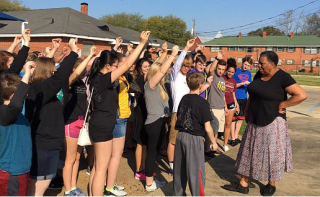When We Get Our Freedom
By Susan Dana Lawrence

Joanne Bland, civil rights activist and tour guide, helped the UU Families section craft this story about her childhood in Selma, Alabama during the dramatic, nationally witnessed events of the 1960s Civil Rights Movement. Many Unitarian Universalists have visited Selma to take her Journeys for the Soul tour into the heart of Selma’s historic march for black voting rights.
Young Joanne did not know what her grandmother and the other adults in Selma, Alabama, were so upset about. Joanne had already learned about “freedom” in school. She knew that in 1863, one hundred and two years ago, Abraham Lincoln had freed all the slaves. So, why was her grandmother going over to Brown Chapel, day after day, for meetings about a fight for freedom?
At the Methodist chapel, songs were sung and plans were made. There was even training, as if for a war. People were pushed and insulted, on purpose—so they could practice not pushing or talking back. This puzzled Joanne, too. It seemed strange that her grandmother’s freedom fight involved keeping calm, acting peaceful, and not fighting back.
One day, Grandma took Joanne to Selma’s downtown to get new shoes. Joanne saw a pair she liked and tried them on. The shoes were too big, so her grandmother asked for a smaller size. But the store clerk said “No.” The clerk demanded that Grandma buy the pair that didn’t fit. They had to, she said, because no white person would ever buy them, now that Joanne’s dirty feet had touched them.
They walked by Carter’s Drug Store. Through the window, Joanne could see the clean, shiny lunch counter where children her age were treated to ice cream served by a waitress. She desperately wanted to sit there, too. “When we get our freedom,” her grandmother said.
That’s when Joanne understood. The adults were fighting for freedom to sit at that counter, to enjoy a nice ice cream on a hot day, to try on shoes without being embarrassed.
Soon Joanne became a Freedom Fighter, too, marching for black voting rights. In February 1965, the Rev. Dr. Martin Luther King Jr. came to Selma to lead the demonstrators in a peaceful march. When the police began to hit and arrest people, Joanne was one of the children taken to jail for several days. Surrounding Joanne in jail were familiar people, young and old, many from the George Washington Carver housing project where she lived. She had known they could be arrested. What might come next? Another step toward freedom.
Joanne marched again on March 7, with several hundred people planning to walk more than 50 miles, to Alabama’s capital city, Montgomery. But police would not let the marchers over the bridge out of Selma. Attacked by police with weapons, some riding on horses, the marchers scattered. Joanne heard screaming all around her. The next thing she knew, she awoke in a car with her head on her sister’s lap. She felt tears drip onto her. She realized it was not tears, but blood from a wound in her sister’s head. History remembers that march as “Bloody Sunday.”
The next march to Montgomery, two weeks later, ended with a rousing speech by Dr. King at the state capitol. Joanne was part of that march, too.
Joanne Bland still lives in Selma today. As times have changed, she has always found new ways to be a freedom fighter. In 1993, she co-founded the National Voting Rights Museum, where anyone can come to learn about the events that happened in Selma—why the march happened, what it accomplished, and what remains to be done. Now retired from the museum, she guides educational tours along the very streets where she lived the fight for freedom in 1965.
Activity
Grandmom, Grandpop, What Did You Do in the Fight for Civil Rights?
Ask someone older than 55 where they were on March 7, 1965. If they were old enough to see a TV newscast or hear the conversations of adults around them, they may remember when police attacked civil rights marchers in Selma. Some folks you talk to may have taken part in the Civil Rights Movement. Ask what they did and how they helped. Some may work on today’s campaign against racism. Others may have a story to tell about a civil rights campaign by another group: women, Native Americans, gay and lesbian people, transgender people, immigrants, or people who have disabilities.
Ask someone you know:
- Where do you see injustice today against African Americans?
- What have you done to confront racism?
- What do you suggest a young person can do?
Additional Activities
Download the Spring 2015 UU World Families Pages (pdf) for more activities.